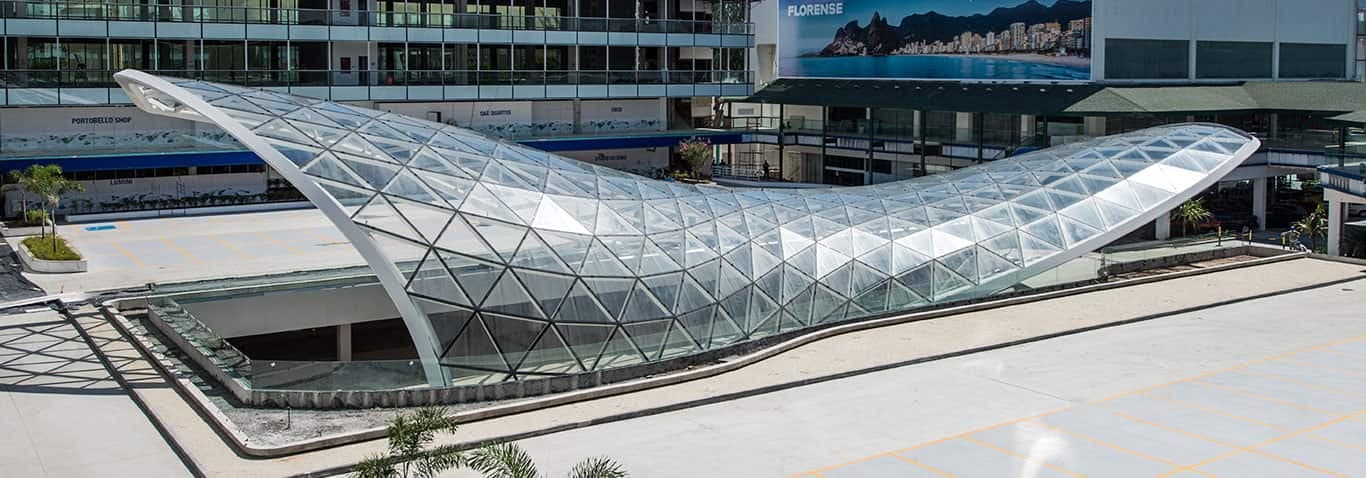
The glass is an integral material for almost all construction projects. Architects are using glass extensively in construction to make the structure sustainable. Due to advancement in technology, various processes are now done on the glass to make it more flexible. When the glass is exposed to direct sunlight, it absorbs some amount of heat, and thus thermal stress develops. Normal float glass can break on prolonged exposure to direct sunlight.
For such purposes, heat strengthened glass must be used. Heat strengthened glass is a processed glass, which has more thermal resistance than float glass. Here we have given brief information on heat strengthened glass, its benefits and application, which homeowners should know before buying glass for their house.

Courtesy – Seele
Heat strengthened glass is a semi-tempered glass which has all properties same as annealed glass or float glass, except strength. Its mechanical strength is twice that of normal annealed glass and half of fully tempered glass. Due to its increased strength, it can resist more wind load, snow load, and thermal stresses.
The float glass panels are washed thoroughly before processing them, to remove dust and dirt on the surface. Before tempering, all the fabrication process such as cutting, drilling, making holes, etc. is carried out. The glass panels are heated in the furnace at the temperature of 650 0C to 700 0C and then cooled. The panels are cooled by releasing air jets on glass panels from all direction, which cools all the surfaces simultaneously. The cooling process is important as it decides the glass will be semi-tempered or fully tempered. The rate of cooling the glass in case of heat strengthened glass is slower than toughened glass, but faster than annealed glass.
Available Size and Thickness:
Heat strengthened glass is available in thickness ranging from 3 mm to 19 mm. The standard size of glass sheets available is 250 mm X 250 mm, and the maximum size is 2400 mm X 4200 mm.
Characteristics of Heat Strengthened Glass:
- It has mechanical strength 2-3 times more than that of float glass. The visible light transmission is same as float glass.
- Heat strengthened has more resistance to thermal stress and thermal shock. It can resist temperature differential up to 130 0C, while annealed glass can resist differential up to 40 0
- Upon breaking, heat strengthened glass cracks radially from the point of impact to the edge of the glass, into sharp and large fragments. This type of breakage system allows the glass to remain in the frame as the large pieces support each other and do not fall out.

Courtesy – Oroglass
- Due to tempering process, the heat strengthened glass becomes optically distorted. However, it is less in magnitude as compared to fully tempered glass or toughened glass. Also, it has more flat surface than toughened glass, hence it is widely used in the layers of laminated glass rather than tempered glass.
- Heat strengthened glass has less susceptibility to breaking spontaneously when it comes in contact with nickel sulfide.
- After production, it cannot be cut, drilled, polished, etc. All these fabrication processes has to be carried out before the tempering process starts.
- Tinted glass, extra clear glass and high performance glasses such as low e glass, solar control glass and solar control low e glass can be processed to produce heat strengthened glass with additional properties.
Application/Uses:
- It is preferred as a structural glass, where additional loads are applied such as wind load, snow load, mechanical load, etc.
- Heat strengthened glass is used for structural glazing as they safeguard against thermal breakages. It can be combined with low e glass and solar control glass to give more high performance glazing.

Courtesy – Seele

Courtesy – Open aire


Courtesy – Active Writing
- For residences in which bedrooms are facing west or south-west, heat strengthened glass is used in windows, to resist the thermal stress. Heat strengthened glass can also be used in glass canopies covering the entrance doors and some part of a backyard to enjoy comfortable sunbath in winters.
- It is used in skylights, glass facades of high rise buildings, canopies, staircase, balustrades, curtain walls, spandrel glass, an exterior pane of insulated glass units, etc.
- Monolithically, heat strengthened glass is used where human impact is negligible and fall out of the glass on breakage is not desired. It cannot be used as safety glazing as sharp fragments of broken glass may cause injuries.
- To use it in safety glazing, it should be used in the form of laminated glass. Hence it can be used in laminated solariums, overhead and sloped glazing,
Heat strengthened glass is expensive as compared to float glass, but has more durability also. It can be used applications in which moderate load is applied. For high load carrying capacity, fully tempered glass must be used.
Also Read:
Characteristics & Properties of Glass as Building Material
Different Types of Glass based on Principal Constituents
Patterned Glass: Architectural Glass With Textures!
History of Glass & Its Invention for Window

































